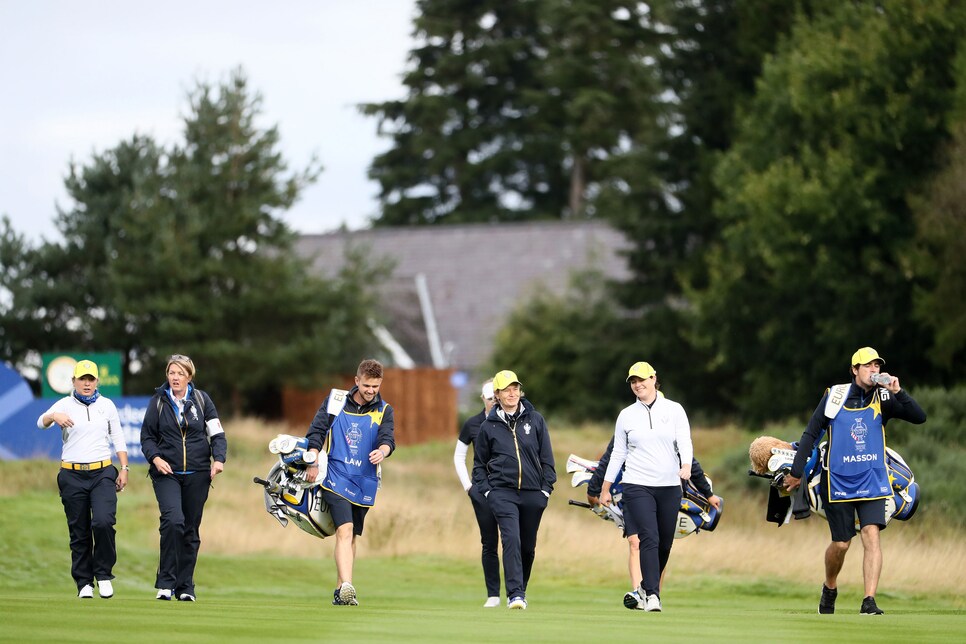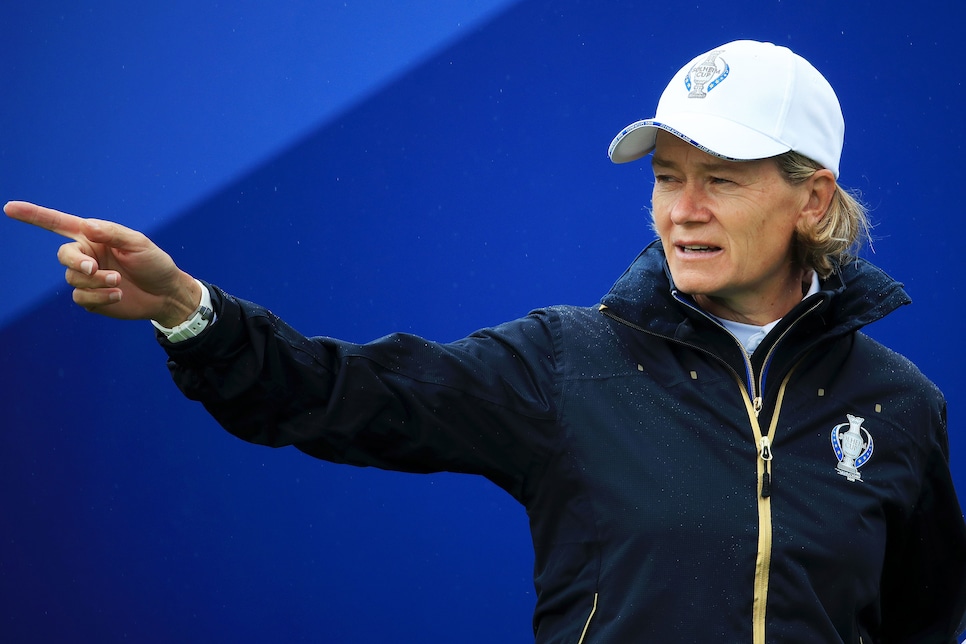The teams are set, automatic qualifiers and captain’s picks alike. Players have arrived on site, their bags unpacked and everyone has settled into their hotel rooms. At this point, what are the Solheim Cup captains doing and thinking?
One who knows exactly is Scotland’s Catriona Matthew. The former Women’s British Open champion, nine times a competitor in the biennial match against the United States, led the European team to victory as captain in 2019 and 2021. Sitting in the kitchen at her home in North Berwick last month, fresh from a third-place finish in the U.S. Senior Women’s Open, the 54-year-old shared what she knows her successor, Suzann Pettersen, and American skipper Stacy Lewis will be going through over the next few days.
Let’s start at the beginning of the week: what’s going through your mind during the first practice round?
The initial practice day is mostly about getting the team comfortable with each other. I deliberately didn’t put anyone out with who I thought they likely would be playing with in the matches themselves. For me, it was more about mixing up the team, maybe putting the more experienced players out with the rookies. I wanted them all chatting to each other, no one left on the outside. The last thing you want in any team is a clique forming.
I actually had a pretty good idea what my first-day pairings were going to be before I even got to the week of the matches. So initially I never really paid too much attention to how anyone was actually playing. I hated practice rounds; I never played particularly well. So I never took much from them when I was captain. It was all about keeping things light-hearted. Let the players have some fun and let them get to know the course.
Only on the second and third practice days did I begin putting them out in with those they were likely to be paired with. It’s good to let them know that, even if I didn’t give them official notification until a little later.
How did you handle the practice days overall? How much play/hitting balls/time at the course did you like to see?
I was very much of the belief that the players should do what they wanted. I did say I wanted them to play nine holes on each of the two days before the matches. On the first day, they all played 18, quite naturally. But I didn’t want anyone to feel like they had to get up super early after that. And I had a wee word with the more experienced players so that they could tell the rookies not to overdo things. First-time players tend to be so keyed up they want to be out there playing and practising too much. They have so many other things to do in the run-up, that can be a real danger. So I was almost holding them back.
OK, let’s talk pairings: how and why did you tend to put people together—and apart?
A lot depends on the make-up of the golf course. Are the par 5s reachable in two? Are the par 3s mostly odd-numbered or even-numbered? Then I looked at the players. Who are the best drivers? Who are the best iron players? Who are the best putters? Then I tried to fit them to the holes where they could use those strengths.
At Gleneagles in 2019, that was a big part of why Georgia Hall and Celine Boutier were paired together. The way that course was—and assuming the players played “regulation golf”—one was going to be doing most of the putting and the other was going to be hitting most of the approach shots. So the plan was to have Georgia hitting from the fairways and Celine putting, which worked well. [The pair went 2-0 in foursomes and 1-0 in four-ball that week.]
I did have slightly different thoughts on four-ball and foursome partnerships. I always preferred foursomes myself. I found four-ball play trickier. I was never the most aggressive player, so in four-balls my tendency was to try too hard to be aggressive. So in four-balls the type of player doesn’t matter much. It’s more about getting them to have two putts for birdie on every green. I never wanted my players going for ridiculous shots. It’s way more important to be in the hole when you get to the green.
How important was it to you that everyone got at least one game before the singles?
My plan was always to get everyone on the course at least once on the opening day. To have to sit for yet another day would make it tough to play well on the Saturday. Plus, I got to see how everyone played under the pressure of the Solheim. And yes, sometimes I had to tell a player she was not going to play on the Saturday. That’s just part of the job. Chances are, someone is not going to be playing well. If you get all 12 on form, you are incredibly lucky.
The role-playing within partnerships is always interesting. At Gleneagles, Suzann Pettersen hadn’t been playing much in the run-up to the matches, so even as the more experienced player alongside Ann Van Dam, her role was to be the steady “par-maker”. Maybe Suzann would throw in the odd birdie, but that was primarily Ann’s responsibility. So it isn’t always the senior player who takes on the senior role.
There are so many roles, both on and off the course. Experience is part of it. So is current form. But it is hard to assume anything. Look at Leona Maguire last time [at Inverness Club in 2021]. She was a rookie, but she played great in every match alongside the more experienced Mel Reid. Then off the course, it is all about getting everyone together. I never wanted to see anyone sitting by herself. Or seeing players who had been in the team previously sticking together. That’s where the vice-captains come in.
What about the vice-captains? How did you pick yours?
I went for a mix of people I knew well and who had very different personalities from my own. I had Laura Davies, who everyone looks up to. She kept everyone loose. Then I had Kathryn Imrie, one of my closest friends. She knows me better than just about anyone. So I knew she would tell me whatever I needed to know, not just what I wanted to hear.
Not everything goes to plan. What didn’t work out for you?
I’ve had to abandon the odd pairing, even when the players have been desperate to play together. Sometimes, you can be too close off the course to gel properly on the course. I have no idea why.
I also had a couple of players who simply did not get on. I was never going to put them together, even when they both said they would play together and try to get on for the sake of the team. They said they disliked each other so much they would make birdies just to annoy each other. Even then, I kept away from that. Too big a risk.
On the other side of that coin, last time at Inverness in Ohio, Mel Reid and Leona Maguire weren’t that keen to play together at first. They went out and won every game. It’s not an exact science.
What about the order you put your players in foursomes and four-balls and singles. Any strategy there?
The order was largely predicated by pace of play, how quick or slow each player was. One player in particular was always last because she is so slow. There would have been no point in putting her out in front of a fast player like Charley Hull. They would just have annoyed both of them. And no, they would never be paired together. That would have driven them both crazy.
As for the singles, I always had those playing best out early. There is no point in keeping anyone for the end, when the contest could be over. I remember Sam Torrance putting out his men at the 2002 Ryder Cup in the order in which they were playing that week. There is something to be said for that. Maybe the only caveat to that is I could have seen myself putting someone playing badly out at the top of the order. Just to get her out of the way. And I do remember noticing that the Americans tended to put their best player out second. Again, no idea why.
Did you ever take into account what your American counterpart might be planning?
I never paid any attention to what the other captain might or might not be doing. My message to my players was always the same: whoever you are playing they are going to be good. You just have to go out and beat them. Besides, I had no idea what the opposing captain was thinking. So making any kind of sensible decision would have been impossible.
Any shocks or surprises along the way?
I wasn’t surprised by too much, although I did have to send a caddie home. But I did make a mistake at Gleneagles when I told everyone on Friday night who was playing on Saturday afternoon. Then I had to tell someone who lost badly on Saturday morning that she wasn’t going to play in the afternoon after all. And I had to do that as soon as she left the course after losing. I didn’t want her to find out by looking at the scoreboard. Needless to say, I didn’t do that again at Inverness. There, I just told them all to be ready to play after lunch if needed. Apart from one, who I knew wasn’t going to play. Saturday afternoon pairings are more difficult than Fridays. Because you are reacting to what has just happened on Saturday morning.
How much did the state of the match affect your singles order?
The score going into the singles is almost irrelevant. Whatever, you have to get blue on the board early. If you’re behind, you have to catch up. And if you’re ahead you are trying to get it done as quickly as possible. There is no point in letting them catch up. Maybe keep one experienced player for near the end. I wouldn’t have, say, three rookies in positions 10, 11 and 12.
Let’s finish with the biggest laugh. Anything come to mind?
In the midst of all this serious stuff, there is room for a bit of fun. What came out of the mouths and into the ears of the off-course team of vice-captains always made me smile. For example, Kathryn and her cart driver were forever looking for each other: “I’m bloody here Kathryn, where you told me to be.” And Laura was forever amused by the downbeat, pessimistic chat and demeanour of another assistant who shall remain nameless.
The biggest laughs last time, however, at least for those in the know, were the references to ABBA song titles players were charged with inserting into their media centre press conferences. No one on the outside caught on, much to the glee of all concerned. And no, I don’t know what is planned for this year. But watch out for any trends.
This article was originally published on golfdigest.com



